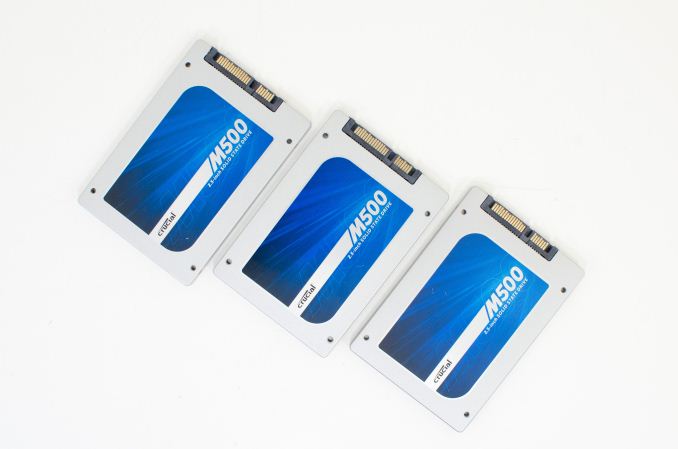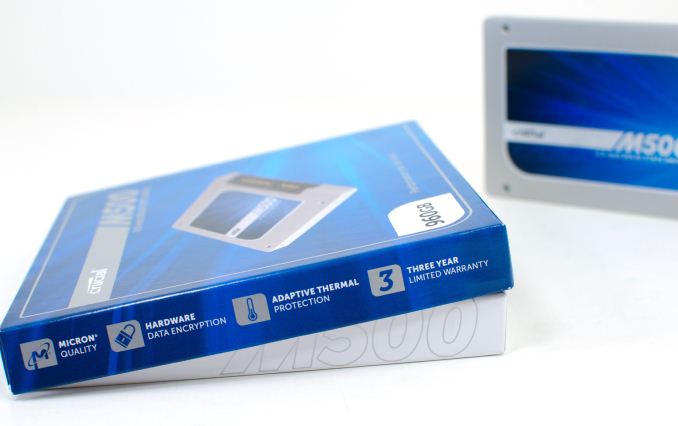The Crucial/Micron M500 Review (960GB, 480GB, 240GB, 120GB)
by Anand Lal Shimpi on April 9, 2013 9:59 AM ESTFinal Words
For SSDs to become more cost effective they need to implement higher density NAND, which is often at odds with performance, endurance or both. Samsung chose the endurance side of the equation, but kept performance largely intact with the vanilla 840. Given that most client workloads aren't write heavy, the tradeoff made a lot of sense. With the M500, Crucial came at the problem from the performance angle. Keep endurance the same, but sacrifice performance in order to hit the right cost target. In the long run I suspect it'll need to be a combination of both approaches, but for now that leaves us in a unique position with the M500.
The M500's performance is by no means bad, but it's definitely slower than the competition. Crucial targeted Samsung's SSD 840, but in most cases the TLC based 840 is faster than the M500. There's probably some room for improvement in the M500's firmware, but there's no escaping the fact that read, program and erase latencies are all higher as a result of the move to larger pages/blocks with the drive's 128Gbit NAND die. The benefit to all of this should be cost, but we'll have to wait and see just how competitive the smaller capacities of the M500 are on cost.
The saving grace when it comes to the M500's performance, at least compared to Samsung's offerings, is worst case IO consistency in a full drive state. If you have the luxury of keeping around 20% of your drive free, Samsung maintains its performance advantage. If, on the other hand, you plan on using almost all of your drive's capacity - the M500 does have better behavior than even the 840 Pro. It's an interesting tradeoff, but going forward I feel like we're going to have to start distinguishing between both usage models. The M500 definitely isn't the best when it comes to delivering both high performance and consistent IO, that title continues to belong to Corsair with its Link_A_Media based Neutron drive. But among the current crop of non-SandForce tier 1 SSD manufacturers, the M500 does reasonably well.
The encryption story on the M500 is potentially very interesting. Assuming the drive is indeed fully supported as a Windows 8 eDrive like Crucial claims, the M500 would be the obvious choice for anyone who had to run with BitLocker enabled. The prospect of seeing more SSDs with hardware encryption that can be leveraged by the OS is downright exciting. Honestly I wasn't aware of the eDrive spec until testing the M500, but now I want to see something similar from Apple as well.
Power consumption is another potentially good story from Crucial, assuming idle power in a notebook is truly as low as it claims. Power under load is competitive with Samsung's SSD 840 Pro, and actually even lower than the vanilla 840. Given that neither of those drives is particularly power hungry, the M500 does well there. Support for DevSleep is a nice addition. The combination of the M500's encryption support and DevSleep give us a good idea of two platform features that we should hope to see from all modern drives during this next generation.
All of this brings us to recommendation time. The easiest of the M500 drives to recommend and dismiss are the highest and lowest capacity versions, respectively. The 960GB M500 is the cheapest 1TB-class SSD I've seen to date, and it's likely the best buy if you need that much storage in a single drive. Performance still falls short of the fastest drives in this space, but if you need the capacity and plan on using all of it the M500 is really the only game in town. I've been hammering on the 960GB very hard over the past few days and while it hasn't been long enough to clear the drive as reliable, so far it's handled everything I've thrown at it very well (including our new Destroyer benchmark). I know I've personally been waiting for a good, high-capacity SSD for notebook use and based on my options today, I'd have no issues going with the 960GB M500.
On the other side of the fence, the 120GB version sacrifices a lot of performance as a result of only using a total of 8 NAND die within the drive. Unless its street price is significantly more attractive than its MSRP, I don't see a reason to choose the 120GB M500.
Recommending the two middle capacities (240/480GB) will really depend on street pricing. Based on their MSRPs, the M500 doesn't appear to be any more competitive here. I suspect that we will see closer-to-840 pricing after a few weeks of being in the channel, at which point they may be worth another look. For now, we play the waiting game.












111 Comments
View All Comments
mayankleoboy1 - Wednesday, April 10, 2013 - link
thanks! These look much better, and more realworld+consumer usage.metafor - Wednesday, April 10, 2013 - link
I'd be very interested to see an endurance test for this drive and how it compares to the TLC Samsung drives. One of the bigger selling points of 2-level MLC is that it has a much longer lifespan, isn't it?73mpl4R - Wednesday, April 10, 2013 - link
Thank you for a great review. If this is a product that paves the way for better drives with 128Gbit dies, then this is most welcome. Interesting with the encryption aswell, gonna check it out.raclimja - Wednesday, April 10, 2013 - link
power consumption is through the roof.very disappointed with it.
toyotabedzrock - Wednesday, April 10, 2013 - link
If you wrote 1.5 TB of data for this test then you used 2% of the drives write life in 10-11 hours.As a heavy multitasker this worries me greatly. Especially if you edit large video files.
Solid State Brain - Wednesday, April 10, 2013 - link
As I written in one of the comments above, they probably state 72 TiB of maximum supported writes for liability and commercial reasons. They don't want users to be using these as enterprise/professional drives (and chances are that if you write more than 40 GiB/day continuously for 5 years you're not a normal consumer). Most people barely write 1.5 TiB in 6 months of use anyway. So even if 72 TiB don't seem much, they're actually quite a lot of writes.Taking into account drive and NAND specifications, and an average write amplification of 2.0x (although in case of sequential workloads such as video editing this should be much closer to 1.0x), a realistic estimate as a minimum drive endurance would be:
120 GB => 187.5 TiB
240 GB => 375.0 TiB
480 GB => 750.0 TiB
960 GB => 1.46 PiB
Of course, it's not that these drives will stop working after 3000 write cycles. They will go on as long as uncorrectable write errors (which increase as the drive gets used) remain within usable margins.
glugglug - Wednesday, April 10, 2013 - link
It is very easy to come up with use cases where a "normal" user will end up hitting the 72TB of writes quickly.Most obvious example is a user who is using this large SSD to transition from a large HDD without it being "just a boot drive", so they archive a lot of stuff.
Depending on MSSE settings, it will likely uncompress everything into C:\Windows\Temp when it does scans each night scan.
You don't want to know how much of my X-25M G1's lifespan I killed in about 6 months time before finding out about that and junctioning my temp directories off of the SSD.
Solid State Brain - Wednesday, April 10, 2013 - link
I am currently using a Samsung 840 250GB with TLC memory, without any hard disk installed in my system. I use it for everything from temp files to virtual machines to torrents. I even reinstalled the entire system a few times because I hopped between Linux and Windows "just because". I haven't performed any "SSD optimization" either. A purely plug&play usage, and it isn't a "boot drive" either. Furthermore, my system is always on. Not quite a normal usage I'd say.In 47 days of usage I've written 2.12 TiB and used 10 write cycles out of 1000. This translates in 13 years of drive life at my current usage rate.
My usage graph + SMART data:
http://i.imgur.com/IwWZ9Kg.png
Temp directories alone aren't going to kill your SSD, not directly at least. It likely was something caused by some anomalous write-happy application, not Windows by itself.
juhatus - Wednesday, April 10, 2013 - link
What would you recommend overprovisioning for 256Gb M4 with bitlocker, 10-15-25% ? Also what was the M4's firmware you used to compare to M500? Also are there any benefits for M500 with bitlocker on windows 7? thanks for review, please add 25% results for M4 too :)Solid State Brain - Wednesday, April 10, 2013 - link
Increasing overprovisioning is only going to matter when continuously writing to the drive without never (or rarely) executing a TRIM operation every time an amount of data roughly equivalent (in practice, less, depending on workload and drive conditions) to the amount of free space gets written.This almost never happens in real life usage by the target userbase of such a drive. It's a matter for servers, for those who for a reason or another (like hi-definition video editing) perform many sustained writes, or for those working in an environment without TRIM support (which isn't the case for Windows 7/8, although it can be for MacOS or Linux - where it has to be manually enabled).
Anandtech SSD benchmarks aren't very realistic for most users, and the same can be said for their OP reccomendations.